Summary
This unit of study is intended to develop student knowledge of the Creole influence on the music of various countries in the Americas: French Guiana, Surname, and the United States. Students will enjoy experiences in listening, singing and playing on instruments, and they will learn to study how different groups of people have influenced one another.
Suggested Grade Levels: 3-5, 6-8
Country: French Guiana, Suriname, USA
Region: The Americas
Culture Group: American Indian, Creole
Genre: Creole music, Cajun music, Zydeco music
Instruments: voice, rhythm sticks, drum, can (used as a drum), accordion, violin, percussion
Language: French, English, Oyampi dialect of the American Indians in French Guiana
Co-Curricular Areas: History, Social Studies, Geography
National Standards: 1, 2, 6, 8, 9
Prerequisites: Knowledge of solfege syllables, AB form, steady beat, ostinato, triple meter, basic body percussion
Objectives:
- Listen to songs and singing styles
- Understand the background of the songs, their sources and origins, their purposes
- Perform a song with one or more musical skill: sing and/or play an ostinato
- Compare and contrast different musical genres
- Develop a timeline of events to show how the different musical genres relate to each other
Material:
- “Vaval” (from the recording Music of the Haut Oyapok)
- “Wang Boto e Kong-One Boat is Coming” (from Creole Music of Suriname)
- “Bon Chien” and “The Back Door/La Porte d’en Arriere” from The Mississippi River Song
- “Cajun Waltz” (from SFW website videos-USA)
- “Orphan’s Waltz” and “Jolie Catin”
- Paper for note-taking purposes, pencils, highlighter pens
- Butcher paper for creating a timeline
- Worksheets with a Venn diagram that has three circles
Lesson Segments:
- A Festive Sound
- Musical Gumbo
Lesson Segment 1. A Festive Sound

“Vaval”
from Music of the Haut Oyapok: Oyampi and Emerillon Indians, French Guiana, South America (1980) | FW04235

“Wang boto e kong - One Boat Is Coming”
from Creole Music of Surinam (1978) | FW04233
- Play the recording, and ask students to think about the mood of the recording prior to playing it. Ask, “What kind of song do you think this is? How does is make you feel?” Students might use descriptive terms such as “it’s happy, upbeat, fun, energizing” etc.
- “Vaval” (from the recording Music of the Haut Oyapok)
- Ask students to listen to the recording again, and to raise their hand when the pattern changes (to a B section). Ask what the form of the song may be, if assigning letters. Students may identify the form as AB, binary, in two contrasting sections.
- Ask students to listen again and to identify the percussive instruments. Ask students whether they have anything at home that might sound like these homemade instruments. Students may offer answers that include a can, chop sticks, trash can.
- Show students the country of French Guiana on a map of the world or of the Americas; check the map in the liner notes or search online for a map of this country.
- Share information about the people singing this song.
- Creole-Indian and Indian canoe pilots from the American Indian tribe Oyampi in French Guiana. They are hunters, gatherers, and fishermen, living in villages that are near river banks and waterfalls. They had not been visited by Europeans until the visit of the explorer from Bauve et Ferre in 1831. They are thought to have fled from the Portuguese across the Amazon River and up the Jari River and into French Guiana in the 18th century.
- Note that the recording took place at Carnival time in Brazil. The music was introduced to men who made trips to St. Georges, a border crossing for Brazil, to get supplies and medical help. Sometimes they had to wait around for a day or two, so they made friends with the Creole people who lived there and that’s how they learned about the Carnival music. The purpose of the song was to serenade the Oyampi village at Camopi, a festive song that was adopted from the Creoles.
- Ask the students to keep a steady beat somewhere on the body while listening to the recording. Ask whether there were repeated rhythmic patterns (yes) and whether they know the term for it (ostinato). Show the notated phrases, asking students to listen to each phrase and sing it back.
A: ms md dr mf mr m
B: ms md dr mf mr d - Encourage students to stand up and move around in a circle, such as in a parade. Ask them to show the percussion instruments that they wish to play.
Extension (Optional):
Authentic assessment of final performances
- Ask students to play small, non-pitched percussion instruments to keep the steady beat or perform an ostinato while they walk in a circle. They can begin moving clockwise in the circle, and change to counterclockwise when a new pattern emerges.
- Encourage half the class to sing the melody while the other half keeps the steady beat and/or plays an ostinato. Have students switch parts.
Assessment:
Students should be able to:
- Identify AB form
- Find a steady beat or ostinato to keep while listening to a recording
- Sing the song accurately while moving to the beat and character of the music.
Lesson Segment 2. I Los’ My Glove

“Bon Chien”
from Calypso Awakening from the Emory Cook Collection (2000) | SFW40453
“The Back Door (La Porte d'en Arrière)”
- Listen to about 30-45 second excerpts of each of the three below-listed recordings. Have students gather in small groups with paper and markers, and challenge them to list what they hear (instruments, voices, words, and descriptors of the sound as loud-soft, fast-slow, smooth-choppy, thin-thick). The featured recordings represent Cajun, Creole, and Zydeco forms.
- “Bon Chien” from The Mississippi River Song
- “The Back Door/La Porte d’en Arriere” from The Mississippi River Song
- “Cajun Waltz” (from SFW website videos-USA)
- Play the 30-45 second recording excerpts again. Direct students to find similarities and differences among the recorded selections. For each listening excerpt, students can use the same colored marker for similar features and choose different colored markers to distinguish dissimilar features.
- Then, still in small groups, challenge students to use a Venn diagram of three intersecting circles for organizing similarities and differences among the recorded selections. They can write the distinguishing features of the three recordings in each of the three circles and then write the common features shared by all three in the center. (Another listen to the recordings may be appropriate. Allow students 30-45 seconds of listening to each of the three excerpts).
- Call the students together to discuss their sorting through the recordings, and their descriptors of similar and distinguishing features. Share the recorded excerpts again, so that students may check their thoughts. Draw a large Venn diagram for all to see, on which the descriptors can be written.
Assessment:
Students should be able to note similar and distinctive features of Cajun, Creole, and Zydeco music.










